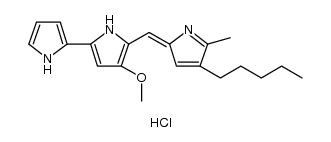Prodigiosin hydrochloride
Modify Date: 2025-08-25 19:01:10

Prodigiosin hydrochloride structure
|
Common Name | Prodigiosin hydrochloride | ||
|---|---|---|---|---|
| CAS Number | 56144-17-3 | Molecular Weight | 359.89300 | |
| Density | N/A | Boiling Point | N/A | |
| Molecular Formula | C20H26ClN3O | Melting Point | N/A | |
| MSDS | USA | Flash Point | N/A | |
Use of Prodigiosin hydrochlorideProdigiosin (Prodigiosine) hydrochloride is a red pigment produced by bacteria as a bioactive secondary metabolite. Prodigiosin hydrochloride is a potent proapoptotic agent, and inhibits Wnt/β-catenin pathway. Prodigiosin hydrochloride has antibacterial, antifungal, antiprotozoal, antimalarial, immunosuppressive, and anticancer properties[1][2]. |
| Name | 2,2'-Bi-1H-pyrrole, 4-methoxy-5-[(5-methyl-4-pentyl-2H-pyrrol-2-ylidene)methyl]-, hydrochloride (1:1) |
|---|
| Description | Prodigiosin (Prodigiosine) hydrochloride is a red pigment produced by bacteria as a bioactive secondary metabolite. Prodigiosin hydrochloride is a potent proapoptotic agent, and inhibits Wnt/β-catenin pathway. Prodigiosin hydrochloride has antibacterial, antifungal, antiprotozoal, antimalarial, immunosuppressive, and anticancer properties[1][2]. |
|---|---|
| Related Catalog | |
| In Vitro | Prodigiosin (25-500 nM; 24 hours) treatment reduces the viability of breast cancer cells, with IC50 values at 48 h of 62.52 nM in MDA-MB-231 cells and 261.2 nM in MDA-MB-468 cells[1]. Prodigiosin (25-500 nM; 24 hours) treatment significantly reduces the levels of phosphorylated LRP6 and DVL2, active β-catenin, and total β-catenin. Prodigiosin noticeably inhibits the phosphorylation of GSK3β at Ser9 in HEK293T cells, which is indicative of an increase in GSK3β activity[1]. Prodigiosin can inhibit proliferation and induce apoptosis in breast cancer cells[1]. Prodigiosin (25-500 nM; 24 hours) treatment dose-dependently blocks Wnt signaling activated by Wnt1, Wnt3, Wnt1/LRP6, Wnt3/LRP6, and Dishevelled 2 (DVL2) in transfected HEK293T cells. Prodigiosin treatment inhibits Wnt3A-CM-induced transcription in a dose-dependent manner. Prodigiosin inhibits transcription of the SuperTopFlash reporter activated by either Wnt transfection or Wnt3A treatment[1]. When applied to cultures of chytrid fungi Batrachochytrium dendrobatidis and B. salamandrivorans, Prodigiosin causes significant growth inhibition, with MIC values of 10 μM and 50 μM, respectively[2]. Cell Proliferation Assay[1] Cell Line: MDA-MB-231 and MDA-MB-468 cells Concentration: 10 nM, 25 nM, 50 nM, 100 nM, 250 nM, 500 nM, 1000 nM, 2500 nM, 5000 nM Incubation Time: 24 hours, 48 hours Result: Reduced the viability of breast cancer cells, with IC50 values at 48 h of 62.52 nM in MDA-MB-231 cells and 261.2 nM in MDA-MB-468 cells. Western Blot Analysis[1] Cell Line: HEK293T cells Concentration: 50 nM, 100 nM, 250 nM, 500 nM Incubation Time: 24 hours Result: Significantly reduced the levels of phosphorylated LRP6 and DVL2, active β-catenin, and total β-catenin. |
| In Vivo | Prodigiosin (5 mg/kg; intraperitoneal injection; twice weekly; for 3 weeks) treatment significantly inhibits tumor growth. Prodigiosin treatment decreases tumor cell density and expression of the proliferation marker Ki-67[1]. Animal Model: Female BALB/c nude mice injected with MDA-MB-231 cells[1] Dosage: 5 mg/kg Administration: Intraperitoneal injection; twice weekly; for 3 weeks Result: Significantly inhibited tumor growth in mice. |
| References |
| Molecular Formula | C20H26ClN3O |
|---|---|
| Molecular Weight | 359.89300 |
| Exact Mass | 359.17600 |
| PSA | 53.17000 |
| LogP | 5.57810 |
| Personal Protective Equipment | Eyeshields;Gloves;type N95 (US);type P1 (EN143) respirator filter |
|---|---|
| RIDADR | NONH for all modes of transport |
|
Synthetic ion transporters can induce apoptosis by facilitating chloride anion transport into cells.
Nature Chemistry 6(10) , 885-92, (2014) Anion transporters based on small molecules have received attention as therapeutic agents because of their potential to disrupt cellular ion homeostasis. However, a direct correlation between a change... |